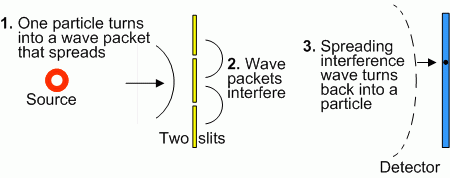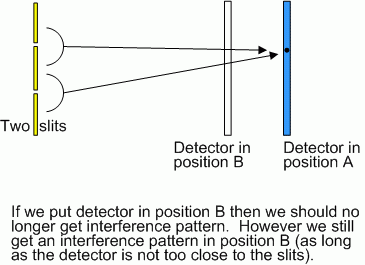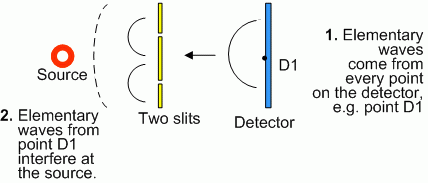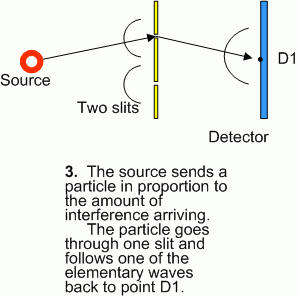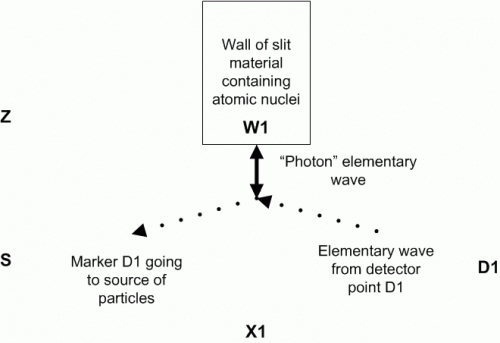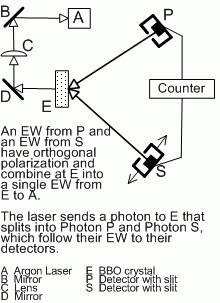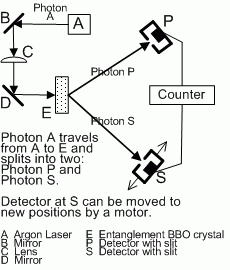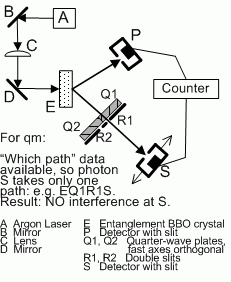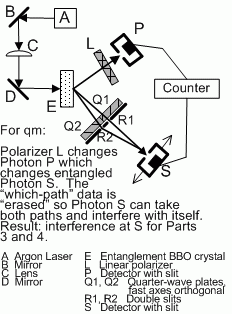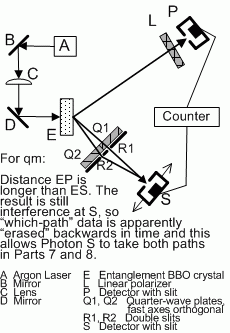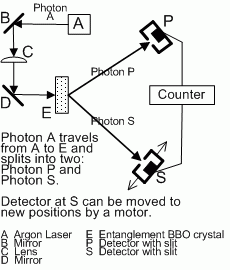

Eugene Morrow
Senior Members-
Posts
73 -
Joined
-
Last visited
Profile Information
-
Favorite Area of Science
Physics
Eugene Morrow's Achievements

Meson (3/13)
8
Reputation
-

Keep the good bit of quantum mechanics
Eugene Morrow replied to Eugene Morrow's topic in Speculations
Studiot, Perhaps I am being too careful. I am trying to stick to Little's writings as best I can. Little is radical enough without me to make the Theory of Elementary Waves (TEW) more so ! I have also learned not to speculate any further than TEW itself. I fiddle around with ideas for unknown aspects of elementary waves and think "Why didn't he try this"? Then later I realise he had tried that idea and it just doesn't fit the behavior we observe. Little has thought of a lot of options, and many more than I have, so I assume now he has reasons for choosing things that I either haven't remembered or he hasn't mentioned yet. I am critical of the explanations of quantum mechanics (qm)? I would say of course I am. The predictions are top quality, and yet the explanations involve competing interpretations with all sorts of strange ideas like a particle being a wave at the same time, multiple universes, effects backwards in time and so on. For about 80 years, the physics community has thought "The predictions work and so we are forced to choose qm - there is no alternative". Now we have an alternative, and I believe that someday physics will realise TEW is the better theory. It's not such a big change - just reverse the direction of the quantum wave, that's all. Physics will then look back at the explanations of qm and wonder why it wasn't obvious that qm struggles to explain things. Anyway, I am still very much interested in your criticisms and questions about TEW. What is obvious to one person is strange to another, and the differences fascinate me. I am still ready to read qm points of view too. Eugene Morrow -

Keep the good bit of quantum mechanics
Eugene Morrow replied to Eugene Morrow's topic in Speculations
Studiot, My credit card is being replaced after being lost, so I am unable to buy online at the moment - should be OK next week. I will buy Frank Wilczek's book when I can. I will also get some articles that me and Uncool are interested in - some discussion of the interpretations of entanglement and the quantum eraser experiment. Looking at the abstracts online I suspect the Wilczek book is very different from the Theory of Elementary Waves (TEW). The really big revolution in TEW is the wave direction (the opposite of quantum mechanics), and if Frank agreed then it would definitely be mentioned in the abstracts. The only similarity I can see is that the abstract suggested empty space somehow participates in mass, which I guess is true for TEW because what we measure as mass is an attribute of the elementary wave that the particle follows. When I get the Wilczek's book I will see if there is anymore similarity than that. I can see your comment about elementary waves possibly being a stream of particles in Post 160, but I cannot see my comment on it in my Post 161. Anyway, speculating that elementary waves are particles is much more of a quantum mechanics (qm) idea. In TEW, waves are waves and particles are particles - there is no "wave-particle duality". A beam of light has both - the elementary waves coming out of the detector and the photons traveling in the reverse direction back to the detector. The things like frequency and wavelength are properties of the elementary waves. The energy that the photons give (such as the photoelectric effect) are a property of the particles arriving at a point. So in TEW there is a clear distinction between what is a wave and what is a particle. So to speculate that elementary waves are a stream of particles is trying to re-introduce wave-particle duality again. Eugene Morrow -

Keep the good bit of quantum mechanics
Eugene Morrow replied to Eugene Morrow's topic in Speculations
Phi for All, Thanks for the assistance. Studiot, I do like your meticulous approach. You sound more and more like a physicist or at least a senior physics student at University. If you are, you are being very patient looking at a new idea - I generally encounter immediate dismissal when physics specialists hear about a new theory. You asked: No, elementary waves are not dispersive - all wavelengths and frequencies travel at the same speed - c. No, elementary waves do not follow an inverse square law so far as documented. Lewis Little is still working on the details of how the Theory of Elementary Waves (TEW) works with general relativity, and obviously the inverse square law of Newtonian gravity will appear at some point. I'm waiting patiently to see what he writes. You wrote: I must have missed your suggestion. You wrote: I assume we are talking about Frank Wilczek? I am not familiar with his model. Are we talking guage theory? Lewis Little has talked a bit about elementary particles and their waves, but not as far as that. Tell me about it. Eugene Morrow -

Keep the good bit of quantum mechanics
Eugene Morrow replied to Eugene Morrow's topic in Speculations
Uncool, Hello - great to hear from you again. Yes, I noticed the comment in Walborn et al 2002 denying backwards in time causality. I have not yet read the two references. While they clearly deny that interpretaton, just what is the quantum mechanics (qm) explanation for the experiment? They offer none. On page 5, just before the Conclusion, they write: To me not attempting to explain what the experiment means is an admission that qm just doesn't really know what is going on. They are claiming that the "which path" information for Photon S was erased (hence the term quantum eraser). The question is - how does that work? Just how does entanglement actually happen, when the change to Photon P happens after Photon S no longer exists? There is a defeaning silence from qm about this. You will see from my writeup, the Theory of Elementary Waves (TEW) does have an explanation - two elementary waves are combined at the BBO crystal. This explains why the polarizer in front of Photon P affects the behavior of Photon S, with everything happening in normal time. I will be most interested to hear what you think is happening in this experiment. Eugene Morrow -

Keep the good bit of quantum mechanics
Eugene Morrow replied to Eugene Morrow's topic in Speculations
Everyone, This site has had a few technical problems the last few days - me and Studiot have had posts duplicated by the software, and others have been cut short. Let's hope the software is stable again. Popcorn Sutton, Like Sheever, you are discussing something completely different to this thread, and not relevant. Please start your own thread and have your own discussion. Kramer, You wrote: I think the double slit experiment has been done with detectors that cover lots of points, so I think there is no problem with the results: we get an interference pattern for sure. That much is agreed by all sides. The problem is explaining how one particle at a time creates that pattern. The Theory of Elementary Waves (TEW) is a very new idea, and I think a lot of people find it hard to accept that the particle and the quantum wave are separate. The reason TEW claims this is because of the explanations of experiments. I find the TEW explanations much more convincing, because there is normal cause and effect. In quantum mechanics (qm) there is the idea of "non-locality" where distant things can affect each other instantaneously without a clear mechanism - for example in entanglement. I guess both qm and TEW are weird in some way, so you have a choice of which weirdness you like more. Studiot, I am hoping our team at least make a worthy opponent. There is nothing wrong with losing as long as you play your best. You wrote; What TEW claims is that what looks like spherical waves coming out of the slits is the result of lots of random collisions by rays in the slit area. I am comfortable with that myself, and the claim in TEW that elementary waves are a flux in empty space, not a wave in a medium. I think you are not comfortable with the appearance of spherical waves. What conclusions are you thinking of? Then you wrote: Here I am ready to grant I think I incorrectly described the TEW picture. Looking back at the TEW literature, I think it is saying that when two rays meet with the same marker, then the waves interfere, not the markers. So the elementary wave rays themselves interfere. So the elementary waves may cancel each other out when reaching the source, and that is why the source does not send a particle in response to that particular wave. So I'll get it right this time - the if the markers are the same then the entire wave interferes. If the markers are different then the waves normally ignore each other. You wrote: The waves do keep going - with a different marker from the last mass they went through. I only draw the elementary waves and markers that we are interested in - the ones that get a particle coming back to the detector. There are elementary waves and markers flying around everywhere. For example, there will be elementary waves coming out of the slit walls to the source and there will be particles going from the source to the slit walls. We don't care about those - the slit wall is not a detector and any particles reaching there are ignored. TEW is saying we live in a universe of elementary waves and markers all over the place. We can't see the waves and markers, just like we can't see gravity. We only know they are there because of the effects. In the case of elementary waves, TEW claims that the success of explaining experiments is enough evidence that the waves exist and behave as described. Your final words are very interesting: I'll give you the quick answer, and then explain more. The quick answer is that TEW claims fields are something we measure (like measuring magnetic forces at a point) and that's all. For TEW there are no fields - there are just elementary waves and particles, so TEW does not use "fields" as a concept to explain why something happens. Now for a bit more explanation. TEW is clearly a rival to qm when describing quantum experiments like the double slit. What will surprise readers of the TEW book is that TEW covers the whole of physics, and all sorts of macro physics have a slightly different expalantion in the light of TEW. For example, we believe in conservation of momentum because, well, it just seems to be that way when we measure it. It's always been conserved in experiments, so we believe it always is. In TEW, the collisions of elementary waves are the reason that momentum is conserved for individual particles. Large collections of particles conserve momentum because all the invididual components do. So one law of physics is related back to this fundamental bit of TEW. Another example of this is electic and magnetic fields. For TEW it is all about elementary waves carrying photons. Chapter 10 of the TEW book deals with magnetism and has a fascinating explanation of Faraday's Law. You get the idea. Whereas both classical and quantum physics talks about fields, for TEW there is no such thing as a field (except in the sense that you can describe the final effect of a force as though it was a field). For TEW, this is a step forward. Using a field as an explanation implies a type of "non-locality" - distance things are affected. TEW likes to describe all of physics by clearly stating how one thing can affect a distant thing, and of course elementary waves are how it happens. Please go ahead and talk about fields. I am just preparing you for my answers which will avoid discussing the field as though it actually is a thing in itself. Eugene Morrow -
Popcorn Sutton, The two theories being discussed here are quantum mechanics (qm) and the new Theory of Elementary Waves (TEW). TEW is a local and deterministic description of all of physics, especially the quantum part, and does not create any new branch of physics. What new branch are you thinking of? Why call it linear continuum physics? Eugene Morrow
-

Quantum Consciousness Vibrations or something like that
Eugene Morrow replied to sheever's topic in Speculations
Kramer, I'm not sure what you mean: What is a hafl circle detector? I think you are saying that a different detector will change the results of the double slit experiment. I need you to talk about this a bit more. Sheever, You are discussing one of the most colorful interpretations of quantum mechanics (qm), where the consciousness of the experimenter makes a difference to the results of the experiment. It can be called the Participatory Anthropic Principle" (PAP) and was partly supported by John Wheeler, a Professor of Physics at Princeton, who had worked with Neils Bohr at times. Stuart Hameroff covers that interpretation, and his video also talks about entanglement where qm claims there is faster-than-light communication between two electrons. I do not accept any interpretation of qm, especially not this one. To me it does not make sense for consciousness of the experimenter to affect the results of an experiment. Why and how could that happen? To me, it's too complicated to consider this possibility. Note that Stuart Hameroff is a doctor, not a physicist. I covered how the Theory of Elementary Waves (TEW) explains entanglement when I was discussing the Quantum Eraser experiment recently. I do not accept entanglement proves that there is faster-than-light communication, or any other mysterious things like effects backwards in time. Hameroff talks about the divide between the quantum world and the classical world. For qm this is a mysterious border where behavior changes a lot. For TEW, it's just the border between when a particle can follow a single elementary wave or when it's too big. They can do the doube slit with large atoms and even with molecules like Bucky Balls (multiple carbon atoms) but the double slit does not work with larger molecules. For TEW, the larger molecules do not follow a single elementary wave, so they follow the usual classical laws of motion and so we don't get the interference pattern. So the border simply represents where we can see the effect of elementary waves in experiments. For TEW, the universe is always local and deterministic - it's just that the elementary waves only affect very small things. Eugene Morrow -

Keep the good bit of quantum mechanics
Eugene Morrow replied to Eugene Morrow's topic in Speculations
Studiot, Why not ditch waves and only talk about markers? Dr. Little will have to have the final answer on that one - there are potentially a lot of reasons. I will have a guess. If you read the book, there are lots of things that are properties of the markers, as we have seen. There are also other things that are properties of the elementary waves that carries the marker. So we need both. Your summary is: I would have said when an elementary wave goes through a mass it gains a marker unique to that mass, and the mass can be a electron, photon or neutron, or even an entire nucleus. A particle follows that marker in the reverse direction. The marker may reach a collision point and jump across to a new elementary wave carrier. Yes, elementary waves extend infinitey in both directions. Let's look at an elementary wave coming out of mass A heading towards point B. Point B is a source of particles - let's say an electron gun in this case. An electron E1 comes out of B and is following the elementary wave marker back to mass A. So between A and the E1 we have marker A, which E1 is following. What about the marker the other side - between E1 and B? In that part of the elementary wave the marker is now E1. So E1 is following the marker A from mass A and E1 is also providing it's own marker to the wave the passes through towards B. I think we have enough now to talk about Young's Double Slit experiment. I will cover both the points of view: quantum mechanics (qm) and TEW. Your questions are good ones - I think you will see a lot more of what TEW claims in this experiment. I will cover the Copenhagen interpretation of the double slit experiment which is the most popular qm interpretation. The idea starts with "wave-particle duality", whereby we think of a particle like a photon or electron as both a wave and a particle. We can call the photon or electron as a "wave-particle" or a "wave packet", and professional physicists talk about "matter waves" for electrons and other masses. As I pointed out before, this assumes that the quantum wave goes in the same direction as the particle does - an assumption that TEW wants to highlight and challenge. The critical part of the double slit experiment is one particle goes through the apparatus at a time, and the pattern on the detector or screen builds up slowly to show an interference pattern. When Einstein gave a convincing case that light was actually particles, and we found a single photon can do all this, Physics said "Huh? How can one particle at a time produce an interference pattern?". In the Copenhagen interpretation of qm, the single wave-particle is spreading and so it goes through both slits. On the other side of the slits it interferes with itself, hence the interference pattern: There are problems with this description. We only ever detect a particle, so somehow the particle switches between a wave and a particle - what controls this? After the slits, there is interference in a wide area because the waves are spreading, so how is a point on the detector selected? In qm, they talk of "wave function collapse", which describes the result, but how does it work? There is a lot of maths, but no picture of what is happening in realtiy. There are two particularly difficult problems for qm - let's call then Mass-Energy issue and the Trajectory issue. The Mass-Energy issue is about accounting for the mass and energy of the particle. If a wave-particle goes through both slits, then we should detect half sized particles if we put a detector in the slits. However, when we do this we only ever detect full sized particles. As well, the waves after the slits are spreading out - why don't we lose mass and energy at the edges? We only ever detect full sized particles - meaning something spread out in a wave suddenly becomes one point. It does not make sense: qm has a tricky tiome accounting for mass and energy between the particle starting the source and arriving at the detector or screen. The Trajectory issue is about moving the detector. Let's look at the two waves after the slits heading towards the detector. Every particle that goes through the slits ends up on the detector somewhere, so the two waves somehow come together every time. If we move the detector a bit closer, all the waves should now miss each other. Yet if we move the detector closer we will get all the particles hitting it, so their trajectories must have changed. How do the particles know that the detector has moved? It's a bit spookly, like Photon S somehow knows that Photon P has hit a polarizer in the Quantum Eraser experiment. It is also like the Neutron Interference experiment I looked at before with Uncool - how did the neutrons know what analzyer crystal is ahead? Note that if we move the detector too close, we don't get any interference pattern at all. if the separation of the slits is "d" then the detector has to stay at least 1000d away from the slits. As long as the detector is at least this far from the slits, we get an interference pattern no matter how we move the detector around. Somehow the particles know where the detector is going to be. So we have two big issues for qm (at least) and they are both very challenging - there doesn't seem to be any obvious answer to either of them. Let's look at the TEW view of this experiment. In TEW, the elementary waves are going in the opposite direction. We are very interested in markers that leave each point on the detector, because particles will later come back here and form the results. Let's look at markers leaving point D1 on the detector. The elementary waves carry the markers to both sltis. Collisions there mean some of the markers end up heading towards the source. When the same markers (D1) encounter each other, the interfere. So we get an interference pattern at the source. If there is constructive interference, then a particle gets stimulated at the source. That is a critical part of TEW - the source does not send particles randomly. Instead, the source sends particle in response to incoming elementary waves. Let's assume D1 has constructive inteference there and a particle begins the return journey following marker D1. The particle only follows one of the incoming D1 markers, so the particle only goes through one slit. In the slits area, the particle has the opposite change of direction to the marker, and ends up traveling towards D1. So point D1 gets a particle. Point D5 may get less particles, because there is less constructive interference at the source. Point D10 get no paricles at all because the D10 markers had destructive interference at the source. Point D15 gets a few, and Point D20 gets a lot. I am just inventing points here, to give you the idea of how the pattern is formed at the detector. Each point is completely indepedent of the others. Why are the points independent? Because they have different markers. The markers from D1 completely ignore the markers from D5, D10 and so on. This is the critical bit for TEW - the markers are the reason why all the points don't interfere with each other - if they did, there would be complete chaos and nothing achieved. Of course the markers are a big issue for TEW - we don't know what they are. Why believe in them? Because the TEW description is now a local and deterministic one. Marker D1 meets another marker D1, so they interfere. That's a very local phenomenon. The source produces particles in response to incoming elementary waves (markers). The markers change diretion at the slits as do the particles in response to other elementary waves from the slit walls - again a local effect. This is a huge difference to qm, which claims non-locality. As well, the two issues for qm are solved. The Mass-Energy of the particle goes through one slit and is always the same throughout the entire journey. Of course the trajectory of the particle changes when we move the detector - something travels from the detector to the particle: elementary waves. The Trajectory issue is easily explained by TEW. So we are left with a choice of theories. I can challenge qm on the Mass-Energy issue and the Trajectory issue. You can challenge TEW on the markers, and you can challenge other things too. I much prefer TEW. Most people choose qm, probably now knowing they have a choice. What do you think? Eugene Morrow -

Keep the good bit of quantum mechanics
Eugene Morrow replied to Eugene Morrow's topic in Speculations
Studiot, It is very impressive how carefully you are checking what I am saying about the Theory of Elementary Waves (TEW). You wrote: It is exactly right that sometimes I talk about individual rays of elementary waves, and these can pass through masses. It is also exactly right that I have shown waves appearing to act like spherical waves. You are questioning how interference happens, and that is a totally sensible question. The answer to all this is that the markers are "carried" by the underlying elementary waves, and the markers behave a bit differently to the wave itself. I will clear this up before giving my description of the Youngs double slit experiment. Yes, an elementary wave itself can go through a mass and gets a new marker. So the old marker is replaced by a new marker. For example, an elementary wave can go through the walls of the slit material and get a new marker and reach the source directly. They will stimulate a particle coming back, which crashes into the walls of the slit material. We're not very interested in those particles, because they don't reach the detector. I also covered how elementary waves can have collisions near an atomic nucleus, where the marker on one wave jumps across to a different wave. Let's look at that again. There is an elementary wave ray coming from point D1 on the detector. It reaches the slit area where it passes close to some masses in the walls of the slit: So we have an elementary wave going from D1 to Z. It is carryinig the marker from D1. There is an elementary wave for a photon coming out of point W1 in one of the slit walls and it's going towards X1. These two elementary waves decide to have a collision. The result is that marker D1 is now traveling towards the Source S from the collision point. Whatever marker was traveling along that path has been replaced by marker D1. The marker has started to spread out - just like a spherical wave you mentioned before. The TEW book doesn't explicitly say what marker travels between the collision point and Z - I think it's still D1. I think the marker W1 is still going to X1, but that marker W1 is definitely also reflecting back from the collision to W1. These are of less interest, because we only care about what arrives back at the detector. It is markers that form interference patterns. So when two markers that are the same meet each other then the markers form the interference pattern. The underlying elementary wave carriers are still there. Interference happens with the markers arriving at the source, and this can stimulate a particle coming back when there is constructive interference. The markers are important because when a particle is following an elementary wave, the particle behaves like the markers, and so can be strictly said to be following the markers back. So the particle coming from the source changes direction just like marker D1 did in the diagram above. Since the particle then gets detected at point D1, it is part of the double slit results. Markers are what really count in elementary waves. So often when we TEW (and I ) talk about elementary waves having collisions and changing direction, we are really meaning what the markers are doing. It is very impressive that you are picking up on the subtleties of elementary waves. Eugene Morrow -

Keep the good bit of quantum mechanics
Eugene Morrow replied to Eugene Morrow's topic in Speculations
This is a day later - some extra thoughts. Studiot, I realise I have not made one point clear enough. When I say "mass" I am meaning electrons, protons and neutrons. These definitely have a unique marker in the Theory of Elementary Waves (TEW). So A and B will be one of these. When you discuss an elementary wave ray partly hitting and partly missing a mass, I am not very interested because the mass is so small. It will be a very impressive experiment if we can demonstrate this for sure, and investigate the results. Your situation will remain unanswered for a long time, I think. Imatfaal, Uncool, I have pointed out that quantum mechanics (qm) does not have an explanation for entanglement in the Quantum Eraser experiment. I can give a new perspective on why qm has a problem here. The foundation of qm is "wave-particle duality". This is the idea that a particle is also a wave - either a "wave packet" or a "wave particle". It is how qm explains the wave behavior of matter, such as the double slit experiment. As soon as you say wave-particle duality, you are making an assumption: that the wave is traveling in the same direction as the particle. Most qm supporters would say this is self-evident. One catch: we don't ever directly see or directly detect a wave - we only detect particles. The particles might be in a wave-like pattern, but we only ever detect individual particles at our detectors. So wave direction is an assumption. In entanglement in the quantum eraser experiment, a photon reaches the BBO crystal and splits into two photons that qm claims are entangled. So a single wave-particle becomes two wave-particles: Photon P going to detector P and Photon S going to detector S. Photon P is a wave and a particle, and so is Photon S. They always have polarizations that are orthogonal, and the sum of the wavelengths totals the wavelength of the photon coming into the BBO crystal. In qm they talk about a "super-position of states", which means a wave-particle can have many possible states, such as polarizations. If we put a polarizer in the path of Photon P, then if we detect Photon P the other side then we know the polarization. Immediately, we know that Photon S has the orthogonal polarization. This works for different polarizer settings for Photon P. How does Photon S know the polarizer setting in front of Photon P? There must be some communication going on between the polarizer setting for Photon P across to Photon S. In qm, there is no reason given for this communication - they just say "entanglement" and that's it. I want to put a new perspective on why qm has a problem explaining how this happens. Focus on the wave direction in qm - the wave travels along with the particle. That means when Photon P and Photon S leave the BBO crystal, they are no longer connected. A wave and a particle head towards detector P and a separate wave and particle head towards detector S. Let's do something really bizarre - let's consider what happens if the wave is traveling in the opposite direction. I know you will say "Huh?" and shake your head. Just take a deep breath and see what happens. The idea in TEW is that a wave goes from A to B first and if B provides a particle then the particle goes backwards from B to A. I've been discussing this with Studiot. That's the essential heart of TEW: a particle is following a wave backwards. Let's apply that to this sitaution. For TEW, there are elementary waves leaving everything in all directions at all times. The ones we are interested in are the elementary waves that will get Photon P and Photon S returning along them. These elementary waves start from detector P and detector S and head towards the BBO crystal. From the TEW point of view, the BBO crystal takes two elementary waves that have orthogonal polarizations, and then combines them into one elementary wave. This combined wave reaches the laser. You can see the elementary waves in the diagram below. The laser sends back a photon in response to the incoming combined elementary wave. At the BBO crystal, the one photon splits into two - the reverse of of the elementary waves that came into the BBO crystal. So now we have Photon P going to detector P and Photon S going to detector S. What is important is that Photon P already knows what polarization it is going to have as soon as it is created. In TEW, the polarization of a photon is an attribute of the elementary wave that it is following. The same for Photon S. Photon P and Photon S have orthogonal polarizations, because the BBO decided to combine to elementary waves with orthogonal polarizations. In the TEW picture, if we place a polarizer in front of Photon P then this changes the elementary wave that travels to the BBO crystal. The BBO crystal selects an appropriate partner elementary wave and it all happens. Photon P and Photon S have orthogonal polarizations at all times thanks to the BBO crystal. Can you see now how entanglement is a local and deterministic process in TEW - the elementary waves are the connection between Photon P and Photon S. The secret to TEW is that the quantum wave goes in the opposite direction. In qm, the wave direction causes all sorts of problems explaining this. There must be communication between Photon P and Photon S, called "entanglement", but there is no mechanism why it happens. There is "super-position of states" until we measure things. There is "non-locality" which is a more general way of describing entanglement. There are also the multiple "interpretations" of qm which allow for multiple universes, and even particles traveling backwards in time. This shows the lengths that qm has to go to in order to explain experiments like this. All of these qm explanations are not necessary in TEW. The wave direction makes TEW much simpler than qm. The wave diretion of TEW may see really strange at first, but after a while it is qm that looks strange in comparison. Eugene Morrow Studiot, I've just seen your reply. Nice to have a Somerset welcome - I'm still pessimistic for the results at the end of the tour. Good point about elementary waves going through masses. To explain the Youngs double slit experiment, I will have to talk about the markers, and how they move around. You can see the idea in the diagram I posted above - the markers start from the detectors and combine in some way at the BBO, and then reach the laser. That is all showing what markers are doing. I will discuss that more in my next post. Eugene Morrow -

Keep the good bit of quantum mechanics
Eugene Morrow replied to Eugene Morrow's topic in Speculations
Studiot, I understand about cricket and googlies - I come from the same nation as Shane Warne (and we're about to lose the Ashes again by an even wider margin). I'm definitely in trouble if I get some Ian Botham deliveries, so I consider myself warned (!) You are asking about the granularity in the Theory of Elementary Waves (TEW) - how wide is an elementary wave? Your example is about a ray going from A to B and part of it hitting B and part of it missing. You wrote: My only answer is that the rays going from A to B all carry the marker from A - the same marker. How many rays there are travelling between A and B appears not explicity defined in TEW but since each photon follows a single elementary wave, then between two mases there should be a lot of rays (since we can assume any mass is larger than a photon). Whether a single ray can partly hit B and partly miss B is an open question as far as I read the TEW material. I really cannot answer you question any further. You could ask a question to Lewis Little himself if you like by going to the website http://elwave.org/ and selecting Resources, and then posting a comnment which contains your question. I imagine either Lewis Little or another physicists Jeff Boyd will answer your question. I suggest this so that you can get the answer directly from them. I do not consider the question worthwhile and will not ask it, because any question at such a minute scale will always have some sort of doubt: we just can't see it directly. To me it's like asking what color an electron is - it's seems a rather unimportant question. You also wrote: Just a minute - I pointed out to others on this thread that qm claims entanglement but do not say exactly how it works. Why throw out TEW just because there is one question not answered yet? That's a double standard. If qm cannot explain how entanglement works, why don't you throw out qm as well? Eugene Morrow -

Keep the good bit of quantum mechanics
Eugene Morrow replied to Eugene Morrow's topic in Speculations
Stutiot, Thank you for going to the trouble to draw a diagram to show that point C on the wave hits B, but point D does not. You are making a point about what happens when part of an elementary wave ray hits a mass and part of it does not. It's a fair enough question. None of the material on the Theory of Elementary Waves (TEW) talks about this situation. Dr. Little has definitely not discussed hypothetical points C and D that are side-by-side like that in the same elementary wave. I can only guess at what Dr. Little might say. My guess is that he would say it's a topic for future research. There are issues like this one, and the issue of what the markers are, where we don't know, and only future experiments and more theorising will provide answers. This is the best I can do. You wrote: I do not agree with the conclusion, because TEW does not make any statements about two such points C and D in the same elementary wave. imatfaal, You wrote: You are denying any communication between the particles. Look closely at the experiment - if Photon P does NOT pass through a polarizer, there is NO interference seen of Photon S, but if Photon P DOES pass through a polarizer there IS interference for Photon S. Why is Photon S affected by what happens to Photon P? Logically, there must have been communication of some sort between the two photons. You are denying the result of the quanum eraser experiment. The whole name of the experiment is about Photon P "erasing" the "which path" information about Photon S. That is an effect. How could Photon P do it? There must be some communication between the Photon P side of the experiment and the Photon S side of the experiment. To me, if you don't know why one part of the experiment (Photon P) affects the other part of the experiment (Photon S) then you don't know what is going on in the experiment. I conclude quantum mechanics (qm) does not know what is going on. In qm, they talk about "entanglement" which implies that one partner particle affects the other, but qm does not say how it happens. What is the mechanism for entanglement? None is ever given in qm. What I like about TEW is that it gives a clear mechanism - elementary waves coming from the detectors. There is a clear reason why we get the results, even when Photon P hits the polarizer after Photon S no longer exists. Everything happens in normal time. I much prefer a theory that can give me a reason why Photon P affects Photon S. Eugene Morrow -

Keep the good bit of quantum mechanics
Eugene Morrow replied to Eugene Morrow's topic in Speculations
Kalynos, You wrote this about entanglement: The whole idea of entanglement in quantum mechanics (qm) is that changing entangled particle affects the other - that's why they call it entanglement. Einstein called it "spooky action at a distance" and that remains a good description of the qm explanation. Uncool is reading an experiment where the experimenters are using this very fact - changing one particle affects the other. The experiment is this one: S. P. Walborn, M. O. Terra Cunha, S. Padua, C. H. Monken, "Double-slit quantum eraser", Physical Review A, Volume 65, 033818, Feb 2002. You can download it for free: [*]Go to http://en.wikipedia....aser_experiment The link is en.wikipedia.org/wiki/Quantum_eraser_experimentzZ I'm very aware of what entanglement is and the eraser experiment, you giving a very common and often related misconception. It is still wrong. -

Keep the good bit of quantum mechanics
Eugene Morrow replied to Eugene Morrow's topic in Speculations
Studiot, Am I still not directly answering your questions? I will keep trying. You wrote: I need to give more detail in my answers. I had explained that Dr. Little is working on how the Theory of Elementary Waves (TEW) works wtih general relativity. That will require that an elementary wave will curve under the influence of gravity. That means that between A and B, it will not be a straight line if there is a gravitational field close by. I am certain Dr. Little would not agree that an elementary wave ray is only in one dimension. His work on general relativity is still going on, so this part of TEW is not yet complete. You wrote: I think you're making the point about the dimensions of a ray, and the idea that parts of a single ray do not hit B. The understanding I have got from his book and article is that a single elementary waves ray is always smaller than the smallest mass, and must be at least as small as a photon, so even though the ray might curve (and hence be in 3 dimensions) the entire ray will either hit B or not hit B. So either the entire ray hits B and emerges the other side with a new marker, or misses B entirely and something else happens. An infinitesimal time after the ray hits B, it now has the marker from B. You wrote: Well said - of course a theory must not contradict itself. One of my own criticism of quantum mechanics (qm) is that to me qm does contradict itself. That is because my idea of the universe is a local and deterministic one with nothing happening backwards in time, so a lot of qm is contradictory on that basis. Of course when people read TEW they will check if TEW contradicts itself. I am not expecting anyone to believe something just be I or Dr. Little said so. I don't believe what qm says even though the predictions are so good. I am only here to debate TEW and qm. The first step is for me to let everyone know what TEW claims, so the debate can then start. I prefer to quote Dr. Little because I want to avoid mis-representing his theory as much as possible. I just want to be fair on his ideas. However, I don't want to go too far and answer nothing, because then there is no debate. So I do the best compromise I can. When you initially say nothing, I assume it is because you are thinking about the TEW position, not because you have accepted anything. I always assume participants like you have a healthy skepticism unless someone comes out and says they agree with TEW (which has never happened). I am interested to see what parts of TEW people choose to question. For example, I have been very surprised by your questions about how many dimensiions a ray is in. There's nothing wrong with you checking TEW out - I find if fascinating to hear how someone else approaches TEW ideas. Cold logic is most welcome. I wish there was more of it in the qm explanations of reality. You wrote: I am reluctant to accept elementary waves as longitudinal waves because of interference patterns. To me, the interference in the double slit experiment seems inconsistent with a longitudinal wave. To my knowledge, Dr. Little has not ever used the term longitudinal in discussing elementary waves, and I assume that is intentional on his part. Uncool, You wrote: The link you provided has the summary of interpretations of qm, but there was no mention of super-determinism. To me, super-determinism is just a concept, not an actual explanation. As others have said, if super-determinism is true, then it's not worth performing experiments because the outcomes are already determined by the universe, and need not make any sense. So super-determinism is just giving up on physics making sense, which I won't do. If you look at the link for entanglement on that page, it says: This is what qm claims - entanglement involves communication between the particles faster than light. You are very rare in claiming that this is not necessary. I talked about qm being non-local (just like the entanglement above) and you wrote: I think that sums up the claims of qm - we need to give up one of the three: locality, determinism or counter factual definiteness. To me that is too much to have to give up one of the three. Philosophically, I judge that all three are valid if a theory is working. In TEW I can have all three, so it wins me. When qm says one of the three must be false, I conclude qm is false purely on the logtical choices it presents. You wrote: I have learned from you another reason I prefer TEW - because I want to keep counterfactual definiteness. Thanks for looking into the Quantum Eraser experiment. There is no rush - I am happy to give you as much time as you want to consider it. I like it that finally we can both see the paper, and both can see the TEW explanation. Eugene Morrow -

Keep the good bit of quantum mechanics
Eugene Morrow replied to Eugene Morrow's topic in Speculations
Studiot, You have an interesting point of view. You wrote: I think Dr. Little would still say that the waves are three dimensional. He has hinted that his work on the Theory of Elementary Waves (TEW) and General Relativity requires that an elementary wave curves under the influence of gravity. So even though an elementary waves is very thin, it still travels in three dimensions. Dr. Little has said that an elementary wave is a flux that propagates in a vacuum (there is no medium). He has not attempted to give dimensions (e.g. thickness) - this is a subject for more research. I don't think he would agree that an elementary wave is one dimensionsal. It would be like saying a photon is one dimensional: it might be very small but we cannot say it has zero width. The same with elementary waves - they are definitely very thin, but it's going too far to say they are one dimensional. You wrote: I am sure Dr. Little would not agree with phrases like "no transverse dimensions to vibrate in". Elementary waves are some sort of flux, that's all we know about them. How far apart to B1 and B2 need to be? We don't know yet, but any two masses that are separate are far enough apart to have a different elementary wave. Why do elementary waves avoid interfering most of the time? Dr. Little bases it on behavior - they only interfere when they have the same marker. He does not know why, mainly because he doesn't know what the markers are. You wrote: Yes. Rays are leaving A in all directions, including the BA direction. So there are rays going outwards from A in all directons and all have the marker from A. All of those rays have different directions, but are otherwise identical. You then asked: The rays leaving A are all going in different directions, so they don't meet each other. They will meet each other when at least one of the markers changes direction, such as at the slits as I described. As for rays coming into A from all directions, they normally have different markers, so they will not interfere. If you set up a double slit arrangement near A, then yes there will be waves coming into A that are interfering. If A is not a source like a light bulb, then A will do nothing in response to the interfering elementary waves. Only sources of particles care about interference. Your questions surprise me and are really fascinating to bring such a different point of view. Uncool, Granted - I'm no good at mind reading ! You did say something that is potentially very controversial: What are these "local interpretations of quantum mechanics"? Do you have any references? The quantum mechanics (qm) I read is explicitly non-local, and qm even claims that a non-local description of the quantum world is not possible. Remember the quote from David Bohm: I would be very interested to see publications claiming a local and deterministic version of qm. It looks like we will not make any further progress on the neutron interference experiment Kaiser et al 1992. I think we should turn our attention to the entanglement experiment I mentioned before. The actual experiment is this one: S. P. Walborn, M. O. Terra Cunha, S. Padua, C. H. Monken, "Double-slit quantum eraser", Physical Review A, Volume 65, 033818, Feb 2002. You can download it for free: Go to http://en.wikipedia.org/wiki/Quantum_eraser_experiment The link is en.wikipedia.org/wiki/Quantum_eraser_experiment Under “External links”, look for “The original paper on which this article is based.” The experiment creates two “entangled” photons, and investigates how one entangled photon appears to affect the other photon backwards in time. The experiment starts with a basic setup to create two entangled photons. See the diagram below. An Argon laser at A creates a photon called Photon A of wavelength 351.1 nm, which is in the ultraviolet part of the spectrum of light. Photon A bounces off a mirror at B to pass through a lens at C which changes the photon in a way to assist results in this experiment. Photon A bounces off a mirror at D to reach a crystal at E. Located at E is a beta Barium Borate (BBO) crystal. This crystal splits Photon A into two photons: Photon P and Photon S, each with a wavelength 702.2 nm (which is twice the incoming photon wavelength). This new wavelength is in the red part of the spectrum of visible light. Photons P and S have orthogonal polarizations which add up to the polarization of Photon A. For qm, Photons P and S are “entangled” which means they are linked: a change to one will change the other instantaneously (while the entanglement lasts). The experimenters then put Photon S through a double slit experiment, and then make changes to Photon P to show it affects the interference of Photon S. The really critical part is that they make the changes to Photon P further way, so that the changes happen after Photon S has finished the double slit apparatus and already been detected. Photon S is still affected, so for qm there absolutely has to be communication between the photons and backwards in time. There is no getting around the qm claims here. TEW can explain the same experiment in a local and deterministic way, with everything happening in normal time. See an explanation that I wrote here: http://www.scribd.com/doc/99753535 I will be most interested to see if you can explain what qm says in this experiment. Eugene Morrow

